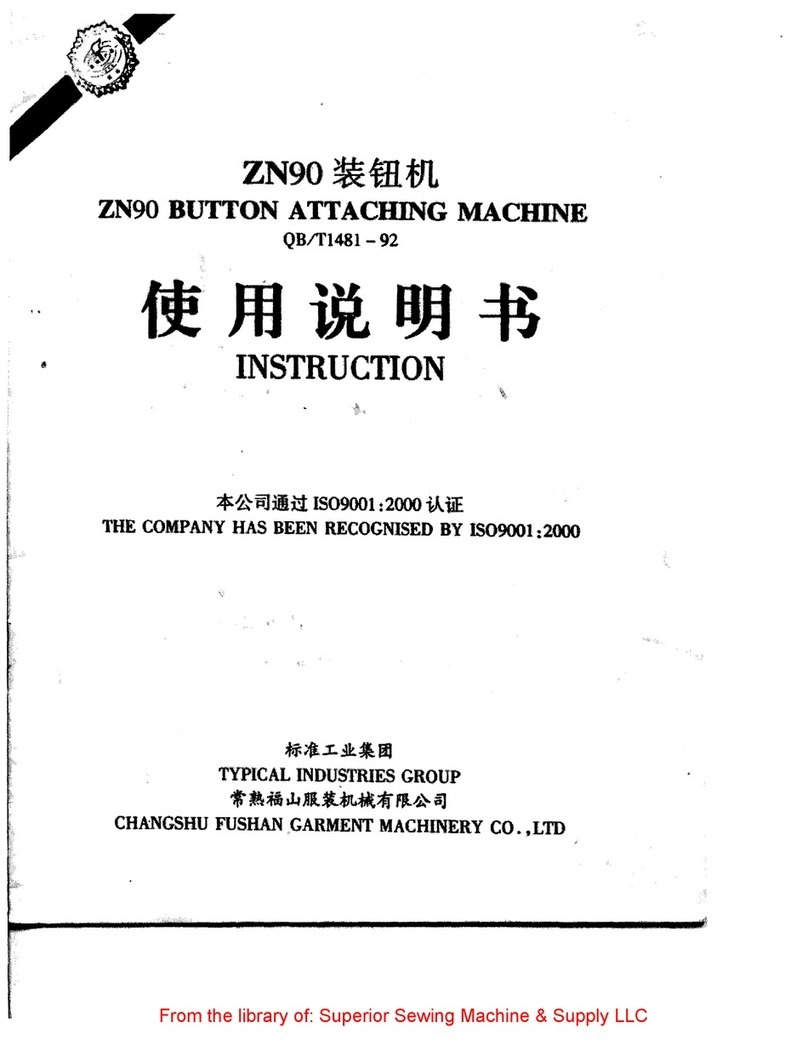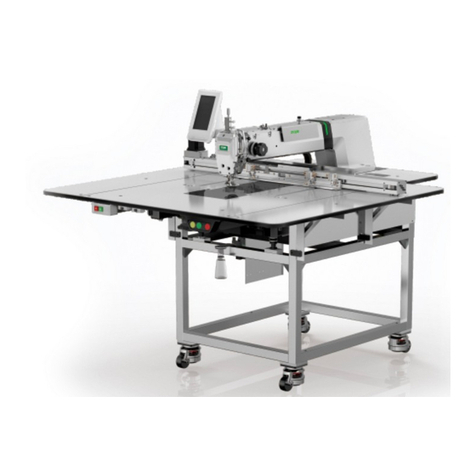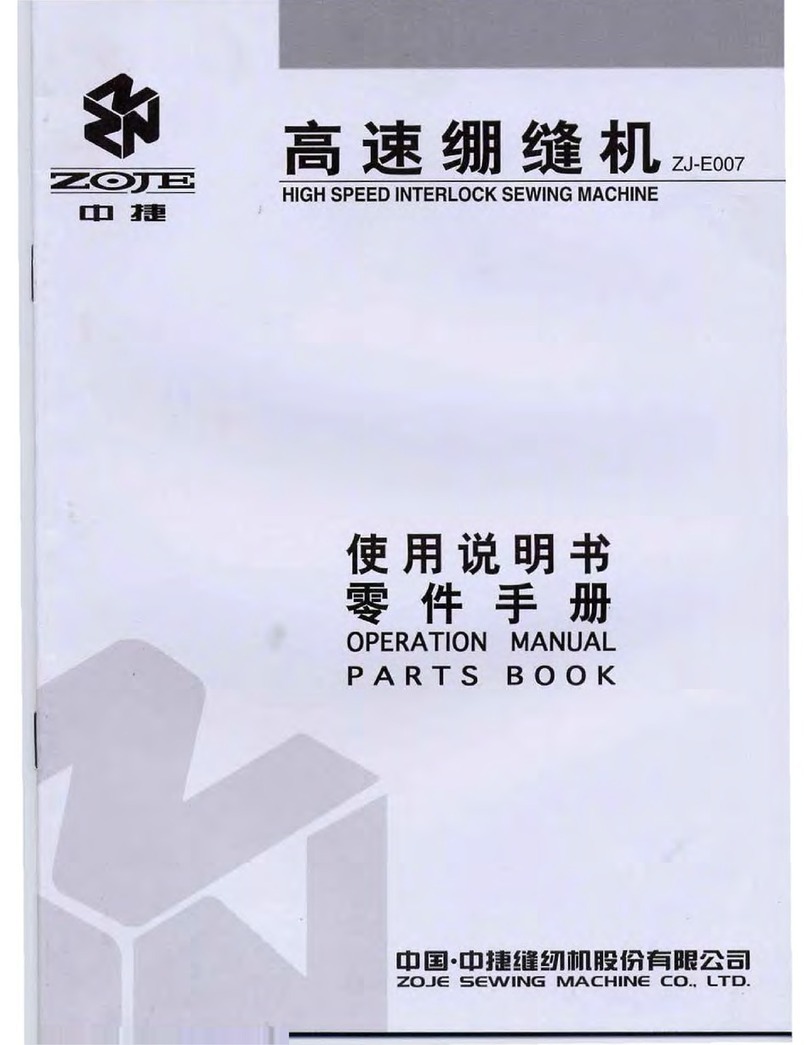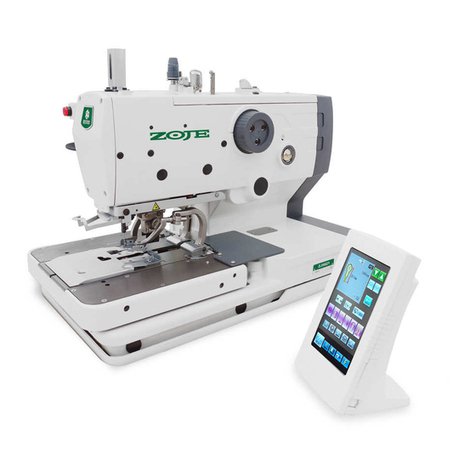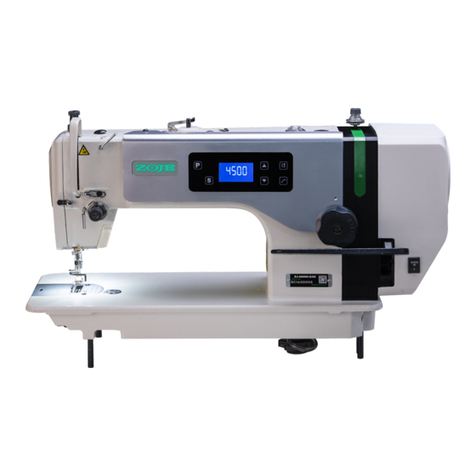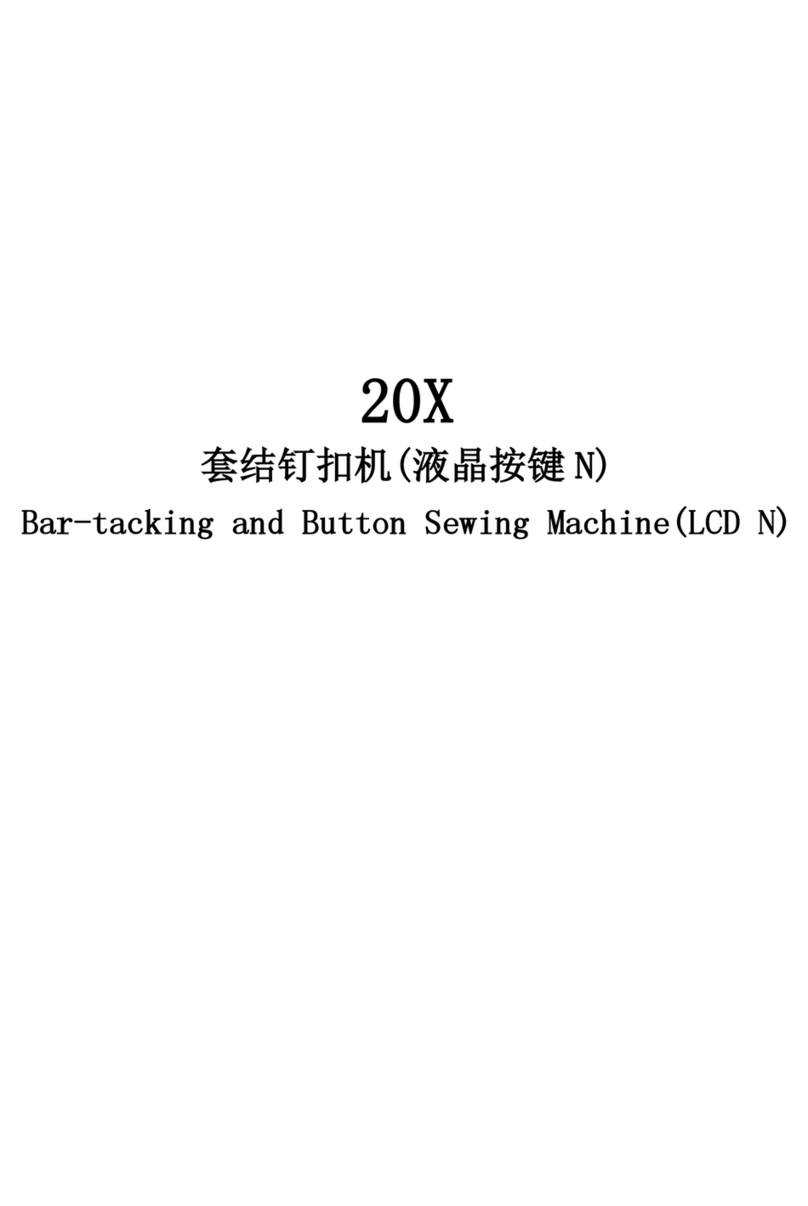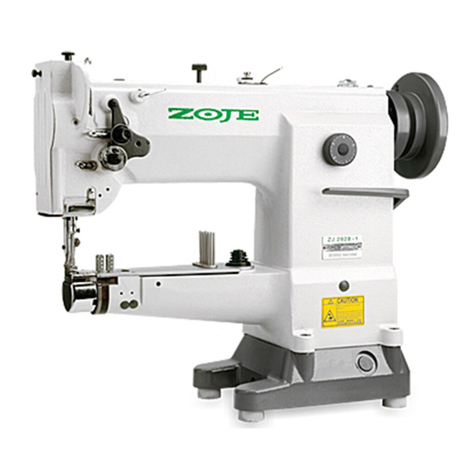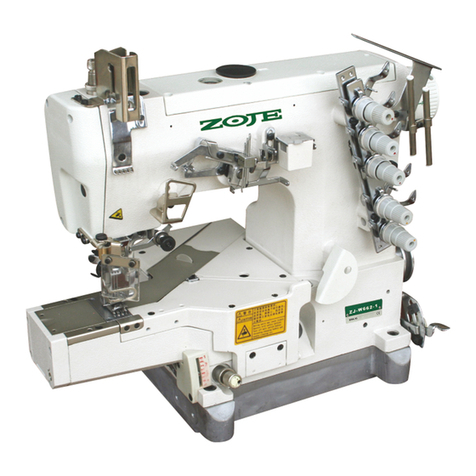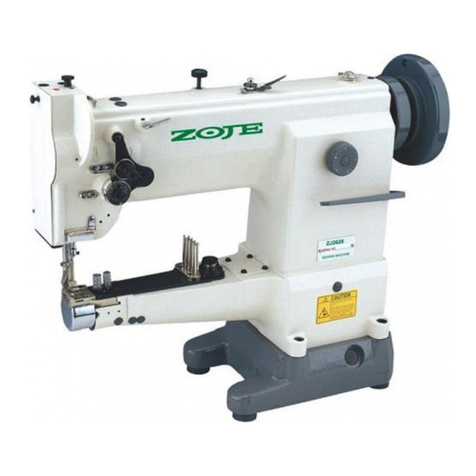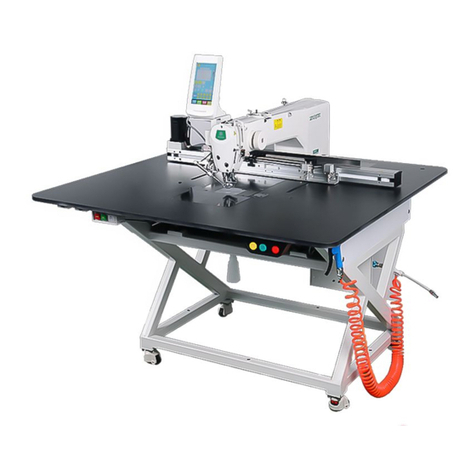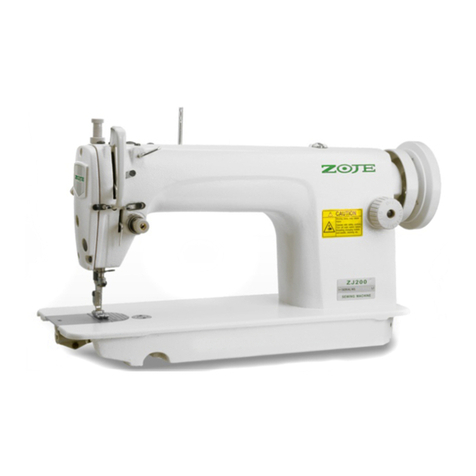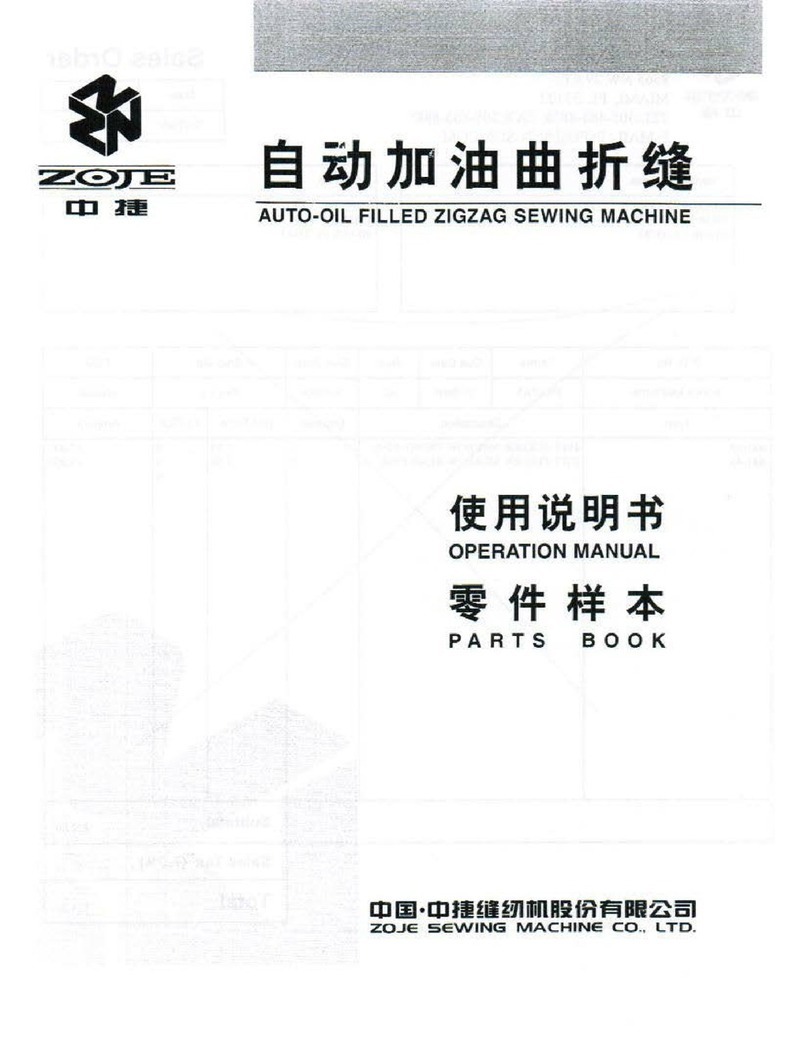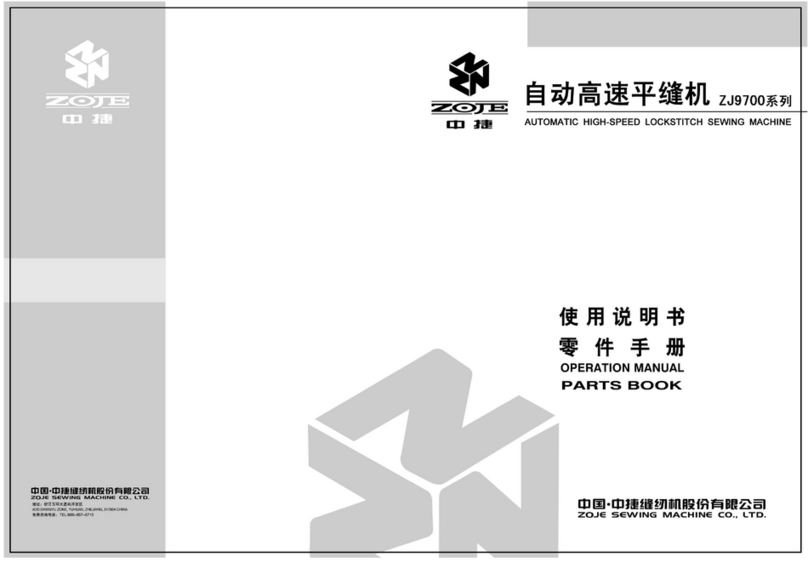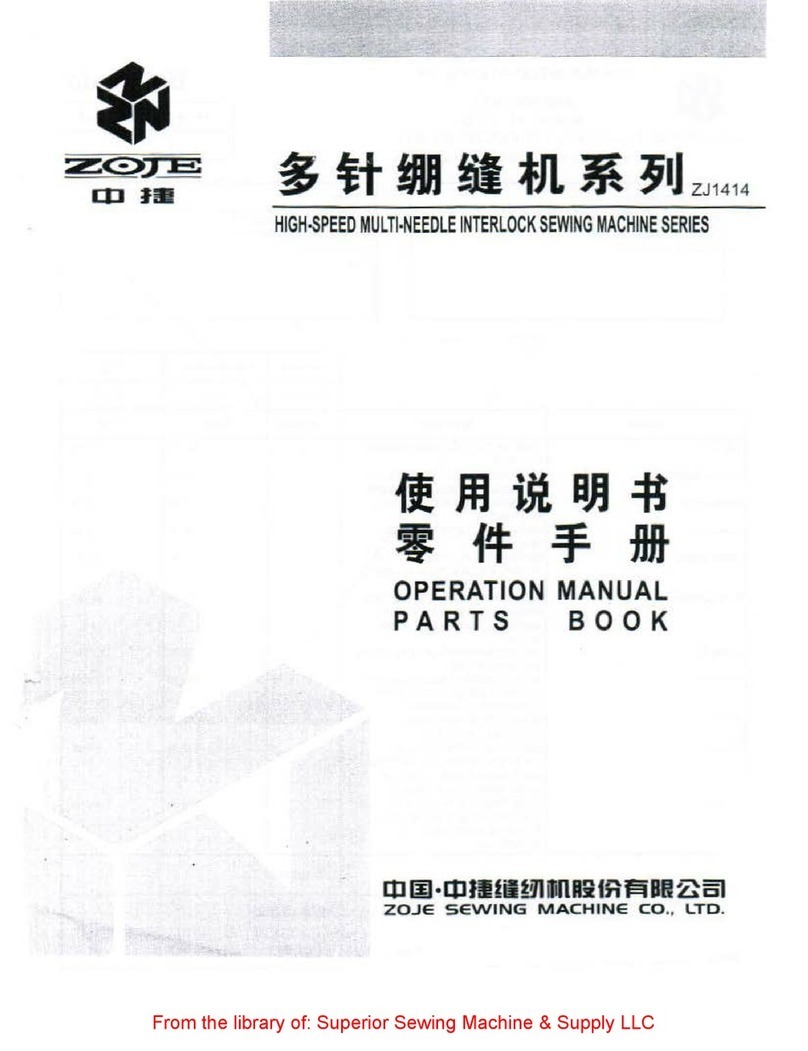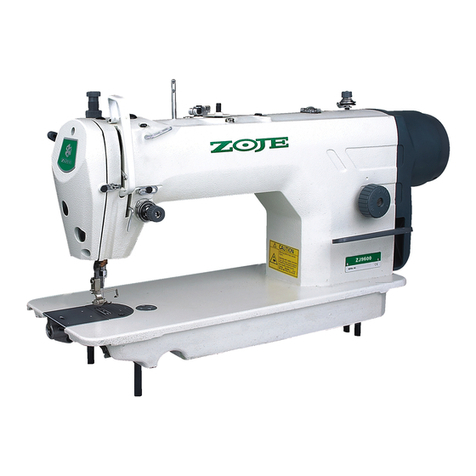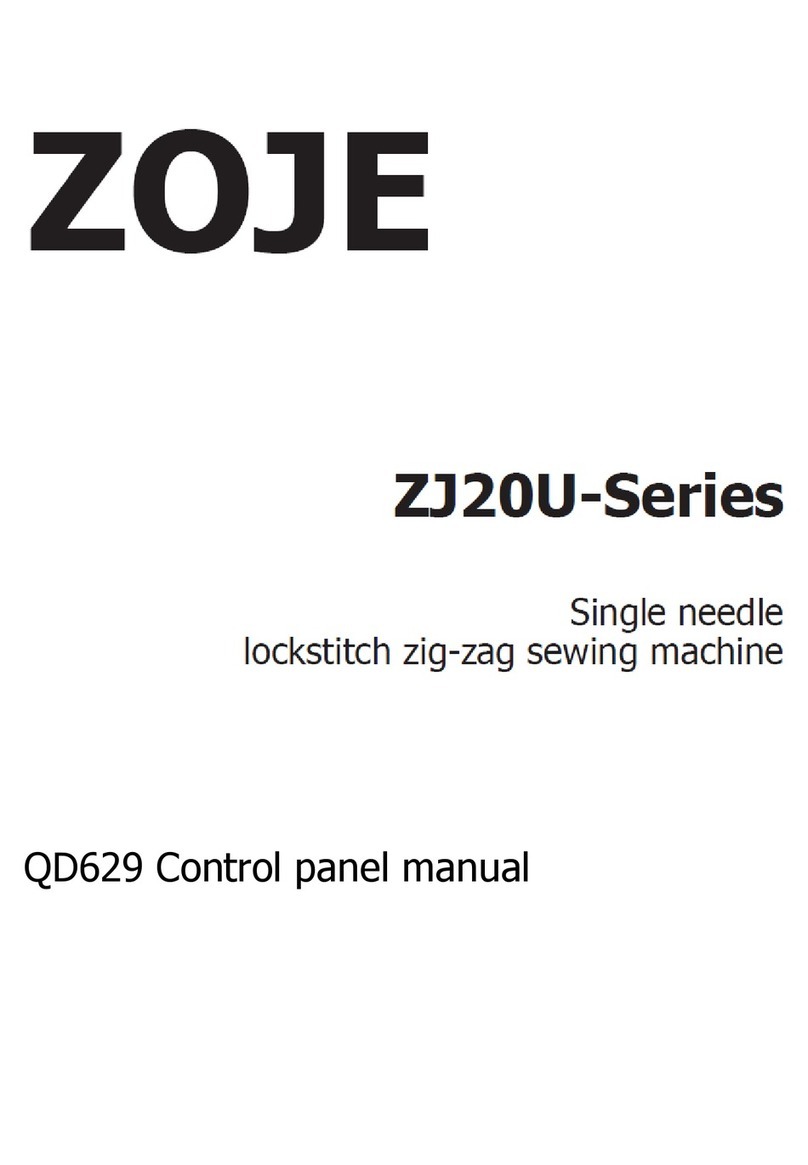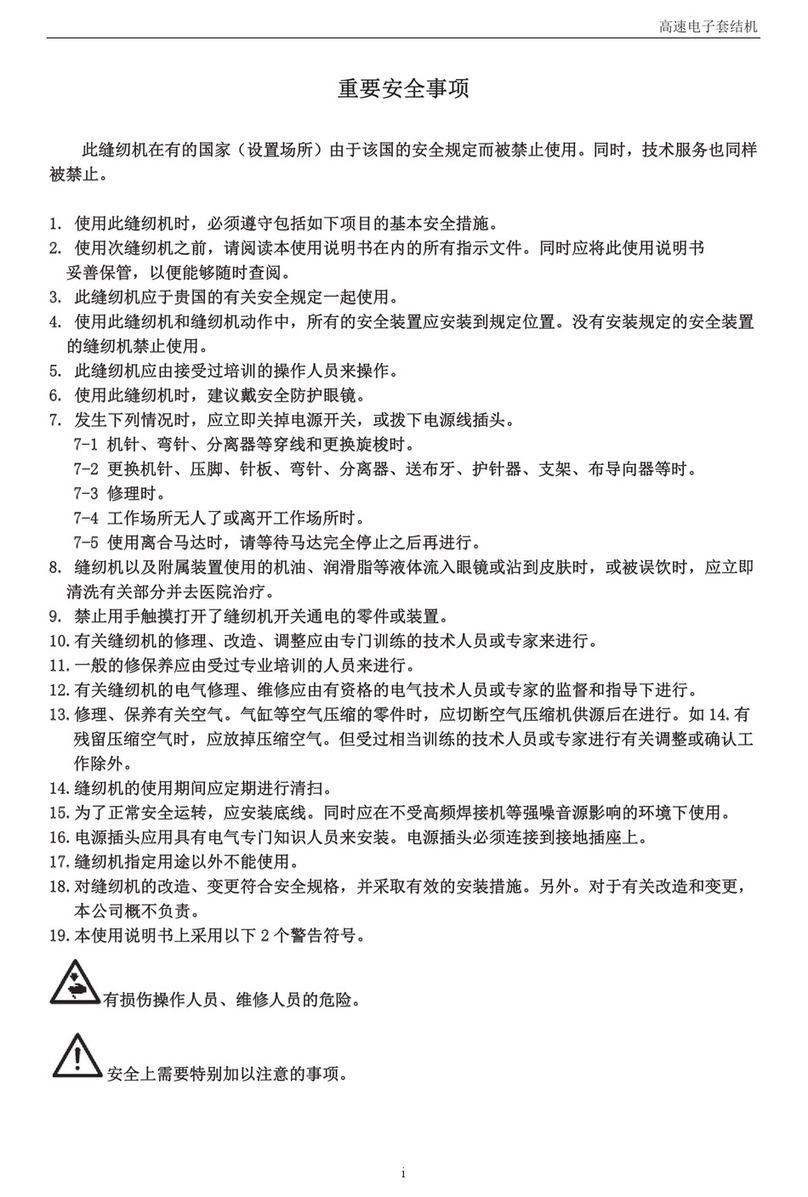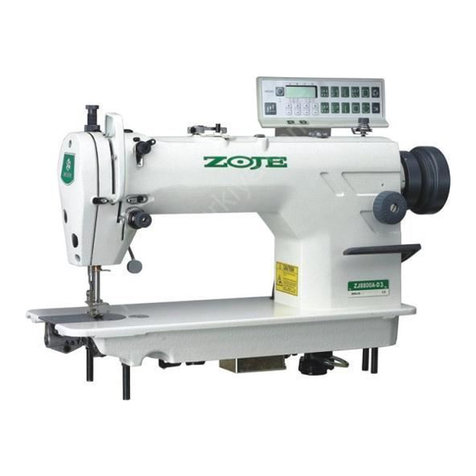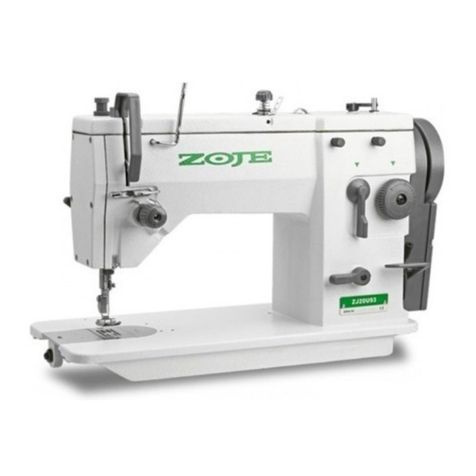ZOJE ZJ2842-BD User manual



NOTES ONSAFETY
CAUTION
Environmental Requirements
Use the sewing maching in an area which
free from sources of strong electrical
noise such as high-frequency welders.
Sources of strong electrical noise may
cause prob-lems with correct operation.
Any fluctuations in the power supply
voltage should be within 1 0% of the
rated voltage for the maching, Voltage
fluctuations which are greater than this
may cause problems with correct
operation.
The power supply capactity should be
greater than the requirements for the
sewing machine s electrical consu-
mption, Insufficient power supply
capacity may cause problems with
correct operation.
The pneumatic delivery capability should
be greater than the requirements for the
sewing machine s total air consumption.
Insufficient pneumatic delivery capability
may cause Problems with correct
operation.
The ambient temperature should be
within the range of 5 to 35 during
use. Temperatures which are lower or
higher than this may cause problems with
correct operation.
The relatove humidity should be within the
range of 45% to 85% during use, and no
dew formation should occur in any
devices. Excessively dry or humid
environments and dew formation may
cause problems with correct operaton
Avoid exposure to direct sunlught during
Use. Exposure to direct sunlight may
cause problems with correct operation.
In the event of an electrical storm, turn
off the power and disconnect the power
cord form the wall outlet. Lightning may
cause problems with correct operation.
Sewing
Be sure to wear protective goggles when using the machine.
If goggles are not worn, there is the danger that if a needle breaks, parts of the broken
needle may enter your eyes and injure may result.
Thank you very much for buying a sewing machine. Before using your new maching, please
read the safety instructionsand the explanations given in the instruction manual.
With industrial sewing machines, it is normal to carry out work while positioned directly in front
of moving parts such as the needle and thread take-up lever, and consequently there is always a danger
of injury that can be caused by these parts. Follow the instructions from training personnel and
instructors regarding safe and correct operation before operating the machine so that you will know
how to uses it correctly.


SAFETY INSTRUCTIONS
Safety indications end their meanings
Symbol
CAUTION
Notes on safety
INSTALLATION
CAUTION
This instruction manual and the indications and symbols that are used on the machine itself are
provided in order to ensure safe operation of this machine and to prevent accidents and injury to yourself or
other people. The meanings of these indications and symbols are given below.
The instructions which follow this term indicate situations where failure to
follow the instructions could cause injury when using the machine or physical
damage to equipment and surroundings.
This symbol ( ) indicates something that you should be careful of. The picture inside
the triangle indicates the nature of the caution that must be taken.
This symbol ( ) indicates something that you must not do.
This symbol ( )indicates something that you must de. The picture inside the circle
indicates the nature of the thing that must be ding that must be done.
(For example, the symbol at left means you must make the ground connection .)
Machine installation should only be
carded out by a qualified technician.
Be sure to connect the ground.If the
ground connection is not secure,
you run the risk of receiving a
serious electric Shock.
Contact you dealer or a qualified
electrician for any electrical work that
may need to be done.
The sewing machine weighs more
than 55kg. The installation should be
carded out by two or more people.
Do not connect the power cord until
installation is complete,otherwise the
machine may operate if the treadle is
pressed by mistake,which could result
in injury.
All cords should be secured at least
25mm away from any moving parts.
Furthermore, de not excessively bend
the cords or secure them too firmly with
staples,otherwise shocks could occur.
Be sure to wear protective goggles and
gloves when handling the lubricating
oil, so that no oil gets into your eyes or
onto your skin, otherwise inflammation
can result.
Furthermose, do not drink the oil under
any circumstances as it can cause vom-
iting and diarrhoea.
Keep the oil out of the reach of children.


This sewing machine should only be used
by operators who have received the
necessary training in safe use beforehand.
The sewing machine should not be used
for any applications other than sewing.
Turn off the power switch at the following
times. The motor will keep turning even
after the power is switched off as a result
of the motor s inertia. Wait until the
motor stops fully before strating work.
When threading the needle.
When replacing the needle and
Bobbin.
When not using the machine and when
leaving the maching unattended.
Attach all safety devices before using the
sewing machine. If the machine is used
without these devices attached. Injury may
result.
Do not touch any of the moving parts or
press any objects against the machine while
sewing, as this may result in personal
injury or damage to the machine.
If an error occurs in maching, or if
abnormal noises or smells are noticed,
immediately turn off the power switch.
Then contact your nearest dealer or a
Qualitfied technician.
If the machine develops a problem.
contact your nearest dealer or a qualified
Technician
Turn off the power switch before carrying
out cleaning. The motor will keep turning even
after the power is switched off as a result of
the motor s inertia. Wait outil the motor stops
fully before starting work.The machine may
operate if the treadle is pressed by mistake,
CAUTION
Sewing
Cleaning
Maintenance and inspection
Be sure to wear protective goggles and
gloves when handling the lubricating oil, so
that no oil gets into your eyes or onto your
skin, otherwise inflammation can result.
Furthermmore, do not drink oil under any
circumstances, as it can cause vomiting and
diarrhoea. Keep the oil out of the reach of
children.
Maintenance and inspection machine
should only be carried out by a qualified
technician.
Ask you dealer or a qualified electrician to
carry out any maintenance and inspection of
the electrical system.
Turn off the power switch and disconnect
the power cord from the wall outlet at the
following thime.otherwisethemachine may
operate if the treadle is pressed by mistake,
which could result in injury. However.The
motor will keep turning even after the power
is switched off as a result of the motors
inertia. Wait until the motor stops fully before
staring work.
When carrying out inspection.
adjustment and maintenance.
Whenreplacing consumable prats such
as the rotary hook.
Any problems in machine operation which
result from unauthorized modifications to the
machine will not be covered by the warranty.
Ifthe power switch needtobe lefton when
carrying out some adjustment,be extremely
care full to observe all safety precautions.
Whencheckingtherotaryhook lubrication,
do not toutch movingpadssuchas the rotary
hook,needle and needle bar with your finger
or paper nor push them with other objects.
otherwise injury or damage to the machine
may result.
Use only the proper replacement pads as
specifiedby our company.
If any safety devices have been removed.
be absolutely sure to re-install them to their
original positions and check that they operate
Correctly before using the machine.

2
3
1
The following warning lables appear on the sewing machine
Please follow the instructions on the labels at all times when using the machine. If the labels have
been removed or are difficult to read please contact your nearest dealer
The following warning lables appear on the sewing machine
Please follow the instructions on the labels at all times when using the machine. If the labels have
been removed or are difficult to read please contact your nearest dealer
2
3
1
Moving parts may cause injury Operate with safety devices
Turn off main switch be fore threading, changing bobbin and needle, cleaning etc.
Moving parts may cause injury Operate with safety devices
Turn off main switch be fore threading, changing bobbin and needle, cleaning etc.
Be sure to connect the ground. If the ground connection is not secure you run the risk
of receiving a seriois electric shock.
Direction of operation
Be sure to connect the ground. If the ground connection is not secure you run the risk
of receiving a seriois electric shock.
Direction of operation
safety devices
Finger guard Thread take-up cover. etc.
safety devices
Finger guard Thread take-up cover. etc.




CONTENTS
1. NAMES OF MAJOR PARTS 1
2. MACHINE SPECIFICATIONS 3
3. OPTINONAL PARTS 5
4. TABLE PROCESSING DIAGRAM 7
5. INSTALLATION 9
5-1.Installing the oil pan 10
5-2.Installing the machine head 11
5-3.Installing the knee lifter assembly 11
5-4.Installtion 13
5-5.Conexion de los cables 15
5-6.Installing the cotton stand 18
5-7.Lubrication 18
5-8.Checking the machine pulley rotating 20
6. PREARATION BEFORE SEWING 20
6-1.Installing the needle 20
6-2.Removing the bobbin or cap 21
6-3.Winding the lower thread 21
6-4.Installing the lower bobbin or cap 22
6-4-1.Installing the bobbin [2842.2872] 22
6-4-2.Installing the cap [2845.2875] 23
6-5.Threading the upper thread 24
6-6.Adjusting the stitch length 25
6-7.Corner sewing method 25
6-7-1.To stop the needle bars 25
6-7-2.Number of stitches: quick-reference guide 26
7. SEWING 27
7-1.Sewing 27
7-2.Backtacking 27
8. THREAD TENSION 28
1. NAMES OF MAJOR PARTS 1
2. MACHINE SPECIFICATIONS 3
3. OPTINONAL PARTS 5
4. TABLE PROCESSING DIAGRAM 7
5. INSTALLATION 9
5-1.Installing the oil pan 10
5-2.Installing the machine head 11
5-3.Installing the knee lifter assembly 11
5-4.Installtion 13
5-5.Conexion de los cables 15
5-6.Installing the cotton stand 18
5-7.Lubrication 18
5-8.Checking the machine pulley rotating 20
6. PREARATION BEFORE SEWING 20
6-1.Installing the needle 20
6-2.Removing the bobbin or cap 21
6-3.Winding the lower thread 21
6-4.Installing the lower bobbin or cap 22
6-4-1.Installing the bobbin [2842.2872] 22
6-4-2.Installing the cap [2845.2875] 23
6-5.Threading the upper thread 24
6-6.Adjusting the stitch length 25
6-7.Corner sewing method 25
6-7-1.To stop the needle bars 25
6-7-2.Number of stitches: quick-reference guide 26
7. SEWING 27
7-1.Sewing 27
7-2.Backtacking 27
8. THREAD TENSION 28

8-1.Adjusting the thread tension 28
8-2.Adjusting the presser foor pressure 29
9. CLEANING 30
10. STANDARD ADJUSTMENTS 31
10-1.Adjusting of the feed dog height 31
10-3.Adjusting the thread tension spring 32
10-4.Adjusting the needle and rotary hook timing 34
10-4-1.Needle rotary hook point gap 34
10-4-2.Clearance between rotary hook timing 34
10-4-3.Clearance between rotary hook and opener 35
10-4-4.Needle bar height and lift amount 35
10-5.Adjusting the rotary hook lubrication amount 40
10-6.Adjusting of the needle and feed timing 41
10-7.Oil adjust at the front of machine 43
10-8.Thread wiper adjustment 44
10-9.Movable and fixed knife adjustment 46
10-10.Teension release 48
10-11.Synchronizer adjustment 49
10-12.Thread trimmer timing adjustment 51
11. REPLACING GAUGE PARTS 52
12. INSTALLING OPTIONAL PARTS 56
12-1.Replacing the rotary hook 56
12-2.Replacing the upper thread tension assembly 59
13. TROUBLESHOOTING GUIDE 61
8-1.Adjusting the thread tension 28
8-2.Adjusting the presser foor pressure 29
9. CLEANING 30
10. STANDARD ADJUSTMENTS 31
10-1.Adjusting of the feed dog height 31
10-3.Adjusting the thread tension spring 32
10-4.Adjusting the needle and rotary hook timing 34
10-4-1.Needle rotary hook point gap 34
10-4-2.Clearance between rotary hook timing 34
10-4-3.Clearance between rotary hook and opener 35
10-4-4.Needle bar height and lift amount 35
10-5.Adjusting the rotary hook lubrication amount 40
10-6.Adjusting of the needle and feed timing 41
10-7.Oil adjust at the front of machine 43
10-8.Thread wiper adjustment 44
10-9.Movable and fixed knife adjustment 46
10-10.Teension release 48
10-11.Synchronizer adjustment 49
10-12.Thread trimmer timing adjustment 51
11. REPLACING GAUGE PARTS 52
12. INSTALLING OPTIONAL PARTS 56
12-1.Replacing the rotary hook 56
12-2.Replacing the upper thread tension assembly 59
13. TROUBLESHOOTING GUIDE 61

1
Face plate Bobbin winder Machine pully Belt cover
Reverse Stitching lever Sftitch length dial Needle plate Thread pillar
Face plate Bobbin winder Machine pully Belt cover
Reverse Stitching lever Sftitch length dial Needle plate Thread pillar
Finger guard Thread take-up coverFinger guard Thread take-up cover

2

3

4

5
The following types of rotary hook are
available. Select whichever one is ayitable
for your application. (The following part
codes are assigned for the rotary hooks in
boxes.)
The following types of rotary hook are
available. Select whichever one is ayitable
for your application. (The following part
codes are assigned for the rotary hooks in
boxes.)
The following types of rotary hook are
available. Select whichever one is ayitable
for your application. (The following part
codes are assigned for the rotary hooks in
boxes.)
The following types of rotary hook are
available. Select whichever one is ayitable
for your application. (The following part
codes are assigned for the rotary hooks in
boxes.)
Part codePart code
Part codePart code
Part codePart code
Applicable modelApplicable model
Applicable modelApplicable model
Applicable modelApplicable model
He rotary hook point is reinforced to improve its durability.
This type is suitable for sewing materials that are hard to
make loops on the surface(like stretcht materials),and that
requiers making contact with the hook point and the needle.
He rotary hook point is reinforced to improve its durability.
This type is suitable for sewing materials that are hard to
make loops on the surface(like stretcht materials),and that
requiers making contact with the hook point and the needle.
Lubrication is not needle.This is the most useful to
prevent oil stains on material and thread.
Lubrication is not needle.This is the most useful to
prevent oil stains on material and thread.

6
The following types of upper thread tension assembly are available for use with deifferent thread take-up
spring types and different thread tension spring strengths.
The following types of upper thread tension assembly are available for use with deifferent thread take-up
spring types and different thread tension spring strengths.
Part codePart code Thread tension spring typrThread tension spring typr Thread take-up spring strengthThread take-up spring strength
B4-177B
B4-177B(A)
B4-177B(B)
Standard
Weak
Very weakVery weak
Double
*Standard part at time of shipment2842 2845 2872 and 2875.
*Standard part at time of shipment2842 2845 2872 and 2875.
(Reference)
Tension spring force(when spring height 12mm)
Standard Approx.49N(Approx.5kgf)
Weak Approx.17.64N(Approx.1.8kgf)
Very weak Approx.2.94N(Approx.0.3kgf)
(Reference)
Tension spring force(when spring height 12mm)
Standard Approx.49N(Approx.5kgf)
Weak Approx.17.64N(Approx.1.8kgf)
Very weak Approx.2.94N(Approx.0.3kgf)

7
* The top of the table should be 40mm in thickness and should be strong enough
to hold the weight and with-stand the vibration of the sewing machine.
* Drill holes as indicated in the illustration below.
* The top of the table should be 40mm in thickness and should be strong enough
to hold the weight and with-stand the vibration of the sewing machine.
*Drill holes as indicated in the illustration below.
A-A
40
245
245
15.5 0.515.5 0.5
3030
(14)
R10
181
40
110
181
0
-0.3
0
-0.3
29.5
0
-0.3
0
-0.3
520.5 0
-0.3
0
-0.3
80.6 +0.3
0
+0.3
0
29
29
2-R10 2-R10
180
80.6 +0.3
0
+0.3
0
15 0.115 0.1
80.5 0.380.5 0.3
223 0.3223 0.3
59 35 28 4-R20
4-R10
69
190
20
7
40
62 76
1200 (181)
R10
535
A
A
35
35
174174
A-A
40
245
245
15.5 0.515.5 0.5
3030
(14)
R10
181
40
110
181
0
-0.3
0
-0.3
29.5
0
-0.3
0
-0.3
520.5 0
-0.3
0
-0.3
80.6 +0.3
0
+0.3
0
29
29
2-R10 2-R10
180
80.6 +0.3
0
+0.3
0
15 0.115 0.1
80.5 0.380.5 0.3
223 0.3223 0.3
59 35 28 4-R20
4-R10
69
190
20
7
40
62 76
1200 (181)
R10
535
A
A
35
35
174174
This manual suits for next models
1
Table of contents
Other ZOJE Sewing Machine manuals
